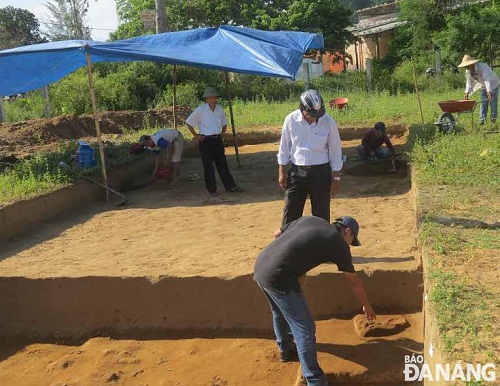Valuable artifacts found at Khue Bac village communal house
According to Vietnamese archaeological experts, the Khue Bac village communal house in Da Nang’s Ngu Hanh Son District is home to many valuable artifacts from the Sa Huynh culture. This civilisation, which thrived in the central and southern regions of Viet Nam between 1000 BC and 200 AD, created a firm foundation for the development of other cultures in Viet Nam over the subsequent historical periods.
In early June, archaeologists from the municipal Centre of Cultural Heritage Management and the Viet Nam Archaeology Institute carried out the excavation of a 100m2 area at the village communal house.
 |
| A scene from the excavation at the village communal house |
A number of valuable artifacts, including stone items, fragments of pottery, pieces of mollusc and old coins, were found at the site. The archaeologists remarked that the findings looked similar to those found during an excavation in 2001 at a location about 10 metres away from this present site.
The 207 stone items discovered at the site included many types of axes, graters, anvils, grinding tables and stones used in making jewellery.
There were also 4,309 fragments of pottery from the Sa Huynh culture, and 175 from the early Champa culture dating back to between the 2nd and 4th centuries. The pottery items from the Sa Huynh culture were enameled either russet or grey, whilst those from the Champa culture were either red or light pink. They are believed to have been used in the daily lives of the Cham people during the period.
There were also 37 Vietnamese pottery items dating back to between the 14th and 20th centuries, and 10 Chinese items dating back to between the 9th and 20th centuries.
In particular, 13 old Chinese coins were also discovered at a depth of about 20cm below the ground surface. One is believed to be from China’s Ming Dynasty (1368-1398) whilst the others are from its Song Dynasty (1024-1100).
All of the new-found artifacts were uncovered in 2 layers at the excavation site. The upper layer featured items dating back to between the 2nd and 20th centuries AD, whilst those found in the lower layer may be from the Sa Huynh culture.
The findings from the lower layer also looked similar to those found during excavations at the Bai Ong relic site on Quang Nam Province’s Cu Lao Cham Islands and at Quang Ngai Province’s Long Thanh archaeological site.